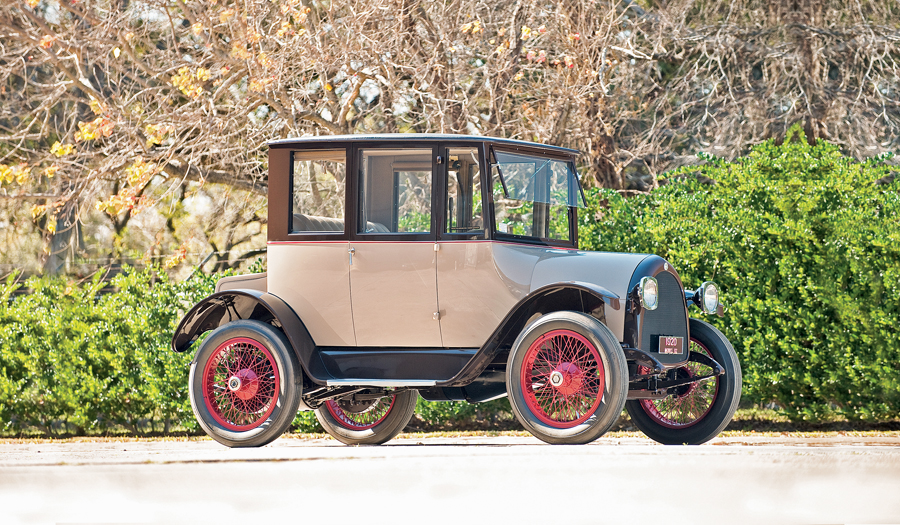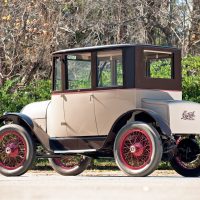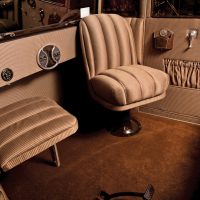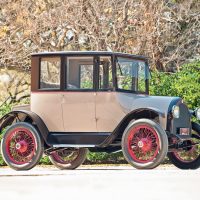This Detroit Electric Model 82 has a 4.3-horspower, 84-volt DC motor, direct shaft drive, solid front and live rear axles with semi-elliptical leaf spring suspension, and rear-wheel mechanical drum brakes. The wheelbase is 100 inches.
Over the course of its 30-year lifespan, the Anderson Electric Car Company, builders of the Detroit Electric, produced more electric automobiles than any other American passenger-car manufacturer. Somewhat in vain, they tried to keep up with modern fashions, and by 1920 had updated their charmingly upright bodies with a dummy front hood and a false radiator, resembling that of a Franklin or Fiat. The bodies were built at H&M Body Corporation of Racine, WI.
This particular car is one of the few of these later Detroit Electrics known to survive, and it is perhaps the only one with a known ownership history since new. Originally built as serial number 12678, it was reassigned its current number, 12578, shortly before being shipped to the Gray-Dort Motor Company, a short distance over the Detroit River in the southwestern Ontario railroad and agricultural town of Chatham, Ontario, CAN.
One of a believed 95 Detroit Electric Model 82s made, and one of very few that remain extant, this car boasts a fascinating and well-known ownership history that is second to none, as well as a high-quality restoration for one of the foremost electric-car collectors.
SCM Analysis
Detailing
| Vehicle: | 1920 Detroit Electric Model 82 Brougham |
| Years Produced: | 1920 |
| Number Produced: | 95 |
| Original List Price: | $2,700 (with upgraded Edison batteries) |
| SCM Valuation: | Median to date, $48,000; high sale, $99,000 |
| Club Info: | Historic Electric Vehicle Foundation |
| Website: | http://www.hevf.org |
| Alternatives: | 1916 Rauch & Lang BX6 Electric, 1903 Waverley 20A Electric, 1913 Broc Model D Electric, 2016 Nissan Leaf, 2016 Tesla Model S |
| Investment Grade: | C |
This car, Lot 119, sold for $66,000, including buyer’s premium, at RM Sotheby’s Motor City auction at the Inn at St. John’s, Plymouth, MI, on July 30, 2016.
The French have a saying, “Plus ça change, plus c’est la même chose,” which translates to: “Outward appearance may change, but fundamentals are constant.”
Never has that been truer than with the electric car. The high-tech electrics we drive today, and those just over the horizon, are certainly more advanced, but in many areas are still fighting the same issues that killed them in the past — range limitations and cheap gasoline. And as yet, they are not broadly loved.
We have forgotten how integral electrics were to the early adopters of horseless carriages of the late 1800s. By 1890, electric vehicles outsold gasoline-powered vehicles by 10 to one. There were charging stations every 10 blocks in New York City at the dawn of the 20th century, and electrics, from sedans to taxis to trucks, were a fixture of city life. They were especially the favorites of doctors and women, both for the lack of a need to hand-crank a finicky gasoline motor and for their operational cleanliness and ease of maintenance.
The death of the electric-car industry came at the hands of the first electric starters for gasoline cars (which removed the “cranky” from your commute), the introduction of mass-production techniques that killed all but the most well-funded car builders, and the lack of rural infrastructure, which precluded electrics from use beyond cities.
Convenience also came with a cost, as the list price of a 1914 Detroit Electric was nearly $2,700, while a Ford Model T was only $600. As today, range was also an issue, with the Detroit Electric going only a claimed 80 miles per charge — in the right conditions.
Anderson and Detroit Electric
Detroit Electric was an outgrowth of the Anderson Carriage Company, with 1907 seeing their first electric-car production. In 1911 they changed their name to the Anderson Electric Car Company, finally becoming the Detroit Electric Car Company in 1920, although all the years of production are called Detroit Electrics.
Although Detroit Electric built 12,690 cars through 1939, only 1,450 were built after 1920, the manufacture year of this car. The demand for electrics was disappearing, with better roads and cheap gasoline for what had been called “exploding engines” only a decade earlier.
After the stock market crash of 1929, Detroit Electric stopped regular production and only did individual orders until they closed. The coachwork for these later cars often came from Willys-Overland (complete with hood louvers).
Driving experience
I didn’t attend the RM Sotheby’s Motor City auction but was privileged to do a tour in Monte Shelton’s 1917 Detroit Electric 5-place Brougham. Shelton is a well-known Portland, OR, car dealer, collector and racer.
Shelton’s car is little changed mechanically from the 1920 version, powered by 14 6-volt batteries (half in front, half in the rear) with 84 volts total, and has a top speed of 30 mph. The changes between 1917 and 1920 were minor, and the cars both enjoy an otherworldly quiet elegance at speed.
The 5-seat carriage is filled with fine brocade seats — and refined touches, such as the crystal flower vase. The seating position is high and the greenhouse is complete, nary a blind spot to find.
Windows go up and down like railroad cars of old, dropped by brocade sashes. Essentially, the car is a parlor on wheels.
The car is ready to go after you lower the steering tiller and the speed-control arm. Release the two-stage brake, which resembles what is found on a modern day golf cart, and off you go.
The Detroit Electric solution to launch control (after all, maximum torque at stall means lighting up the tires or breaking components if you don’t apply the power smoothly) is a series of settings that gradually increase the amount of power getting to the motors. It essentially acts like a 10-speed transmission, all done mechanically as a cylinder rotates and adds contacts to the power supply (think the switch on your ceiling fan).
Instrumentation is at a minimum, amps and volts registering on a gauge on the front floor, far away. The solid front axle and rear semi-elliptical suspension give it a gentle ride, although the high center of gravity and skinny tires make it a pure boulevardier.
Like our modern-day electrics, the Achilles’ heel is the battery pack, and you can expect to spend a couple of thousand dollars to replace the set. And the mechanical brakes leave you anxious about modern traffic.
Those are quibbles, though. It’s an easy-to-use, comfortable vehicle, and Shelton and his wife are regularly seen out to dinner in Portland in the Detroit Electric. And even at rest, Shelton finds the interior is so comfortable and homey that he often retires to the cockpit to read the Sunday newspaper.
Electrics and the collector car market
Our subject electric car has a long, continuous ownership history, and electric-car collector James Cousens gave it a full restoration some years ago. This is a well-restored, rare vehicle with a well-documented history.
It sold for $66,000, at the low end of the estimate of $60,000–$80,000.
Despite being at the low end of the estimate, this car is well ahead of the market, which seems to place little value on early electric cars. Most recent sales of electric cars, whether survivors or ground-up restorations, have hovered in the mid-$40,000 range.
Why doesn’t the market value the cars? Markets, after all, are never wrong, they just are. It could be the lack of utility, as a 30-mph car with a short range keeps you from doing much with it beyond local parades, car shows and Sunday drives.
As electric cars begin to take over our current new-car market, you might see more interest in examples of the historic origins of the post-gasoline world, but for the time being, petro-heads rule the day. For better or worse, it keeps the value down on quality electric cars. So it seems both buyer and seller got a good deal. ♦
(Introductory description courtesy of RM Sotheby’s.)



